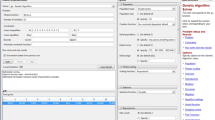Abstract
Cellular manufacturing emerged as a production strategy capable of finding sure issues of complexness and long manufacturing lead times in batch production. One of the major problems encountered in the development and implementation of cellular manufacturing is that of cell formation. The existing algorithm focuses on improving the grouping efficacy by reducing number of exceptional elements and voids. The lesser the number of exceptional elements and voids, the more efficient is the algorithm. The existing similarity coefficient method clustering algorithms are suffering from a common problem called chaining problem. In this paper, a new algorithm is proposed based on similarity coefficients for the cell formation. The proposed algorithm exhibits better results compared to existing algorithms by eliminating the chaining problem effectively. Grouping efficiency (η), grouping efficacy (μ), number of exceptional elements (EE), grouping index (γ) and grouping measure (\(\upeta_{g}\)) are the performance measures used for the analysis.
Access this chapter
Tax calculation will be finalised at checkout
Purchases are for personal use only
Similar content being viewed by others
Abbreviations
- CMS:
-
Cellular manufacturing system
- GT:
-
Group technology
- CF:
-
Cell formation
- CLCA:
-
Complete linkage clustering algorithm
- SLCA:
-
Single linkage clustering algorithm
References
Chan, F.T.S., Lau, K.W., Chan, P.L.Y., Choy, K.L.: Two-stage approach for machine-partgrouping and cell layout problems. Robot Comput. Integr. Manuf. 22(3), 217–238 (2006)
Wemmerlov, U., Hyer, N.L.: Cellular manufacturing in the U.S. industry: a survey of users. Int. J. Prod. Res. 27(9), 1511–1530 (1989)
Burbidge, J.L.: Production flow analysis. Prod. Eng. 42, 742 (1963)
Burbidge, J.L.: Group-Technology in Engineering Industry. Mechanical Engineering Publication Ltd., UK (1979)
Mitrofanov, S.P.: Nauchnye osnovy gruppovoy tekhnologii (Scientific principles of group technology). 475 (1959)
McAuley, J.: Machine grouping for efficient production. Prod. Eng. 51, 53–57 (1972)
King, J.R.: Machine-component group formation in-group technology. OMEGA 8, 193–199 (1980)
King, J.R.: Machine-component grouping in production flow analysis: an approach using a rank order-clustering algorithm. Int. J. Prod. Res. 18, 213–232 (1980)
Shafer, S.M., Rogers, D.F.: Similarity and distance measures for cellular manufacturing. Part II. An extension and comparison. Int. J. Prod. Res. 31(6), 1315–1326 (1993)
Shafer, S.M., Rogers, D.F.: Similarity and distance measures for cellular manufacturing. Part I. A survey. Int. J. Prod. Res. 31(5), 1133–1142 (1993)
Chan, F.T.S., Abhary, K.: Design and evaluation of automated cellular manufacturing systems with simulation modelling and AHP approach: a case study. Integr Manuf Syst 39–52 (1996)
Yin, Y., Yasuda, K.: Similarity coefficient methods applied to the cell formation problem: a comparative investigation. Comput. Ind. Eng. 48(3), 471–489 (2005)
Wafik, H.K., Masmoudi, F., Haddar, M.: Formation of machine groups and part families in CMSs using a correlation analysis approach. Int. J. Adv. Manuf. Syst. Technol. 36, 1157–1169 (2008)
Brotolini, M., Manzini, R., Accorsi, R., Mora, C.: An hybrid procedure for machine duplication in CMSs. Int. J. Adv. Manuf. Technol. 57, 1155–1173 (2011)
Kumar, S., Sharma, R.K.: Development of a cell formation heuristic by considering realistic data using principal component analysis and Taguchi’s method. J. Ind. Eng. Int 11(1), 87–100 (2015)
Khorasgani, S.M.S., Ghaffari, M.: Developing a cellular manufacturing model considering the alternative routes, tool assignment, and machine reliability. J. Ind. Eng. Int. 14(3), 627–636 (2018)
Yin, Y., Kazuhiko, K.: Similarity coefficient methods applied to the cell formation problem: a taxonomy and review. Int. J. Prod. Econ. 101, 329–352 (2006)
Wei, J.C., Gary M.K. Commonality analysis: A linear cell clustering algorithm for group technology. Int. J. Prod. Res. 27(12), 2053–2062 (1989)
Chow, Wing, S., Hawaleshka, O.: An efficient algorithm for solving the machine chaining problem in cellular manufacturing. Comput. Ind. Eng. 22(1), 95–100 (1992)
Seifoddini, H.: A note on the similarity coefficient method and the problem of improper machine assignment in group technology applications. Int. J. Prod. Res. 27(7), 1161–1165 (1989)
Chow, Wing, S., Hawaleshka, O.: Minimizing intercellular part movements in manufacturing cell formation. Int. J. Prod. Res. 31(9), 2161–2170 (1993)
Yang, M.S., Yang, J.H.: Machine-part cell formation in group technology using a modified ART1 method. Eur. J. Oper. Res. 188(1), 140–152 (2008)
Rajesh, K.D., Krishna, M.M., Ali, M.A., Chalapathi, P.V.: A modified hybrid similarity coefficient based method for solving the cell formation problem in CMS. Mater. Today Proc. 4(2), 1469–1477 (2017)
Venugopal, V., Narendran, T.T.: Cell formation in manufacturing systems through simulated annealing: an experimental evaluation. Eur. J. Oper. Res. 63(3), 409–422 (1992)
Kusiak, A., Cho, M.: Similarity coefficient algorithms for solving the group technology problem. Int. J. Prod. Res. 30(11), 2633–2646 (1992)
Wang, J.: Formation of machine cells and part families in CMSs using a linear assignment algorithm. Automatica 39, 1607–1615 (2003)
Albadawi, Z., Bashir, H.A., Chen, M.: A mathematical approach for the formation of manufacturing cells. Comput. Ind. Eng. 48(1), 3–21 (2005)
Murugan, M., Selladurai, V.: Formation of Machine Cells/Part Families in Cellular Manufacturing Systems Using an ART-Modified Single Linkage Clustering Approach—A Comparative Study. Jordan J. Mech. Ind. Eng. 5(3), (2011)
Wuttinan, N., Busaba, P.: Fuzzy multi-objective cell formation model for cellular manufacturing system. In Iaeng Transactions On Engineering Technologies, vol. 7, pp. 174–187 (2012)
Chandrasekharan, M.P., Rajagopalan, R.: An ideal seed non-hierarchical clustering algorithm for cellular manufacturing. Int. J. Prod. Res. 24, 451–464 (1986)
Author information
Authors and Affiliations
Corresponding author
Editor information
Editors and Affiliations
Rights and permissions
Copyright information
© 2021 Springer Nature Singapore Pte Ltd.
About this paper
Cite this paper
Kumar, L., Sharma, R.K. (2021). An Efficient Algorithm for Solving Cell Formation Problem in Cellular Manufacturing. In: Tyagi, M., Sachdeva, A., Sharma, V. (eds) Optimization Methods in Engineering. Lecture Notes on Multidisciplinary Industrial Engineering. Springer, Singapore. https://doi.org/10.1007/978-981-15-4550-4_19
Download citation
DOI: https://doi.org/10.1007/978-981-15-4550-4_19
Published:
Publisher Name: Springer, Singapore
Print ISBN: 978-981-15-4549-8
Online ISBN: 978-981-15-4550-4
eBook Packages: EngineeringEngineering (R0)



